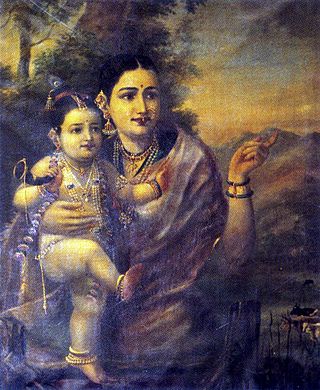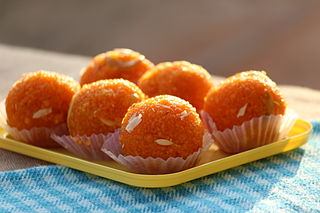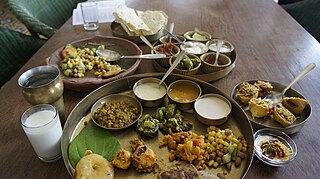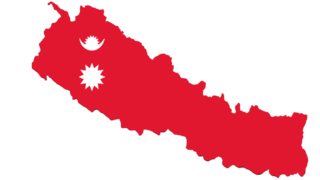
Krishna Janmashtami, also known simply as Krishnashtami,Janmashtami, or Gokulashtami, is an annual Hindu festival that celebrates the birth of Krishna, the eighth avatar of Vishnu. In certain Hindu texts, such as the Gitagovinda, Krishna has been identified as supreme God and the source of all avatars. Krishna's birth is celebrated and observed on the eighth day (Ashtami) of the dark fortnight in Shravana Masa or Bhadrapada Masa. This overlaps with August or September of the Gregorian calendar.

Laddu or laddoo is a spherical sweet from the Indian subcontinent made of various ingredients and sugar syrup or jaggery. It has been described as "perhaps the most universal and ancient of Indian sweets."

Mysore pak is an Indian sweet prepared in ghee. It originated in the city of Mysore, one of the major cities in the Indian state of Karnataka. It is made of generous amounts of ghee, sugar, gram flour, and often cardamom. The texture of this sweet is similar to a buttery and dense cookie. It is also popular in the neighboring country Bangladesh and it's known as Monsur there.

Rajasthani cuisine is the cuisine of the Rajasthan region in North West India. It was influenced by various factors like the warlike lifestyles of its inhabitants, the availability of ingredients in an arid region and by Hindu temple traditions of sampradayas like Pushtimarg and Ramanandi. Food that could last for several days and could be eaten without heating was preferred. Scarcity of water and fresh green vegetables have all had their effect on the cooking. Signature Rajasthani dishes include Dal Baati Churma, Panchratna Dal, Papad ro Saag, Gatte ro Saag. It is also known for its snacks like Bikaneri bhujia, Mirchi bada and Kanda kachauri. Other famous dishes include Dal Baati, malaidar special lassi (lassi) and Lashun ki chutney, Mawa lassi from Jodhpur, Alwar ka mawa, Malpauas from Pushkar and rasgulla from Bikaner, "paniya"and "gheriya" from Mewar. Originating for the Marwar region of the state is the concept Marwari Bhojnalaya, or vegetarian restaurants, today found in many parts of India, which offer vegetarian food of the Marwari people. The history also has its effect on the diet as the Rajputs preferred majorly a non-vegetarian diet while the Brahmin, Jains, and others preferred a vegetarian diet. So, the state has a myriad of both types of delicacies.
Mithai (sweets) are the confectionery and desserts of the Indian subcontinent. Thousands of dedicated shops in India, Bangladesh, Nepal, Pakistan and Sri Lanka sell nothing but sweets.

Shrinathji is a form of Krishna, manifested as a seven-year-old child (Balak). The principal shrine of Shrinathji is the Shrinathji Temple in the temple city of Nathdwara, 48 kilometres north-east of Udaipur city in Rajasthan,India. Shrinathji is the central presiding deity of the Vaishnava sect known as Pushtimarg or the Vallabha Sampradaya, established by Vallabhacharya. Shrinathji is worshipped mainly by the followers of Bhakti Yoga and the Vaishnavas in Gujarat and Rajasthan, and Bhatias amongst others.

Pushtimarg, also known as Pushtimarg sampradaya or Vallabha sampradaya, is a subtradition of the Rudra Sampradaya (Vaishnavism). It was founded in the early 16th century by Vallabhacharya (1479–1531) and is focused on Krishna. A bhakti (devotional) school, Pushtimarg was expanded by the descendants of Vallabhacharya, particularly Gusainji. Its values are derived from and its universal-love-themed devotional practices center around the legendary amorous plays of youthful Krishna, such as those found in the Bhagavata Purana and those related to Govardhana Hill. Pushtimarg sampradaya recognizes Krishna by many names and epithets, such as Sri Nathji, Sri Navanitpriyaji, Sri Madanamohanji, Sri Mathureshji, Sri Gokulnathji, Sri Vittalnathji and Sri Dwarkadhishji.

Gujarati cuisine is the cuisine of the Indian state of Gujarat. The typical Gujarati thali consists of rotli, dal or curry, rice, and shaak. The thali will also include preparations made from pulses or whole beans such as moong, black eyed beans etc., a snack item (farsaan) like dhokla, pathra, samosa, fafda, etc. and a sweet (mishthaan) like mohanthal, jalebi, doodh pak etc.

Sindhi cuisine refers to the distinct native cuisine of the Sindhi people from Sindh, Pakistan. Sindhi cuisine has been influenced by Central Asian, Iranian, Mughal food traditions. It is mostly a non-vegetarian cuisine, with even Sindhi Hindus widely accepting of meat consumption. The daily food in most Sindhi households consists of wheat-based flat-bread (phulka) and rice accompanied by two dishes, one gravy and one dry with curd, papad or pickle. Freshwater fish and a wide variety of vegetables are usually used in Sindhi cuisine. Restaurants specializing in Sindhi cuisine are rare, although it is found at truck stops in rural areas of Sindh province, and in a few restaurants in urban Sindh.

Kadhi, or karhi, is a popular dish mainly consumed in South Asia. It consists of a thick gravy or soup based on gram flour, and it may contain vegetable fritters called pakora, which include dahi (yogurt) for a sour taste. It is often eaten with cooked rice or roti. Varieties of kadhi include those from Rajasthan, Maharashtra, Gujarat, Punjab, and Sindh, all of which are located in present-day India and Pakistan.

Peda or Pera is a mithai from the Indian subcontinent. It originated from Mathura, Uttar Pradesh, India. Usually prepared in thick, semi-soft, its main ingredients are khoa, sugar and traditional flavorings including cardamom seeds, pistachio nuts and saffron. Its colour varies from a creamy white to a caramel colour. The word peda is also generically used to mean a sphere of any doughy substance such as flour or khoa. Variant spellings and names for the dessert include pedha, penda and pera.

Besan Chakki or Besan Katli or Besan Khandli is a common chakki sweet from the Indian subcontinent. It is made with besan, condensed milk, and sugar.

Panjiri is a Indian Ayurvedic sweet dish which is made from whole-wheat flour fried in sugar and ghee, heavily laced with dried fruits and herbal gums. The sweet Panjiri developed from Ayurvedic preparation called Panchajīraka; which is given to women after delivery for puerperal disorders. Similarly, the sweet is ceremoniously eaten by women after giving birth as a nutritional supplement, to promote healing and lactation, or eaten in general in the winters to ward off cold.Hence, Panjiri is one of the quintessential delights of Krishna Janmashtmi bhog offered to Lord Krishna and his mother during his birth.

Govardhan Puja, also known as Annakut or Annakoot, is a Hindu festival celebrated on the first lunar day of the bright fortnight of the month of Kartika, on the fourth day of Diwali. Devotees worship Govardhan Hill and prepare and offer a large variety of vegetarian food to Krishna as a mark of gratitude. For Vaishnavas, this day commemorates the incident in the Bhagavata Purana when Krishna lifted Govardhan Hill to provide the villagers of Vrindavan shelter from torrential rains. This incident symbolizes God offering protection to devotees who take singular refuge in him. Devotees offer a mountain of food, metaphorically representing the Govardhan Hill, to God as a ritual remembrance and to renew their faith in taking refuge in God. The festival is observed by most of Hindu denominations all over India and abroad.

Laapsi or lapsi is an Indian sweet dish which has a lot of variants and is made using grain flour or broken wheat and ghee, along with milk, nuts, raisins and other dried fruits. Lapsi is commonly prepared during Hindu ceremonies, and is served as a religious offering to Devtas. Lapsi forms an integral part of North Indian cuisine.

Madan Mohan Temple is a Hindu temple situated at Karauli, in the Indian state of Rajasthan. The temple is located on the banks of the Bhadravati River, a tributary of the Banas River in the hills of Aravali. It is located in the braj region. The temple is dedicated to Madan Mohan form of Krishna. In the central altar, Krishna is flanked with the icons of his consort Radha and Lalita on either side.

Maithil cuisine, also known as Mithila cuisine, is a part of Indian and Nepalese cuisine. It is the traditional cooking style of Maithils residing in the Mithila region of India and Nepal.
Fafda is a popular Indian snack native to Gujarat. Often eaten during festivals, fafda is rectangular in shape and yellowish in color.

















